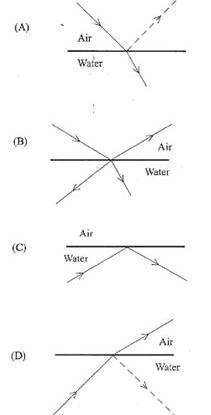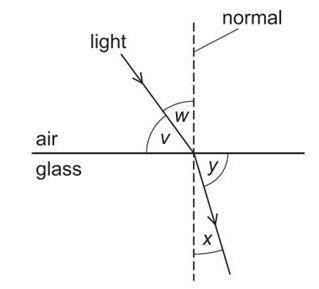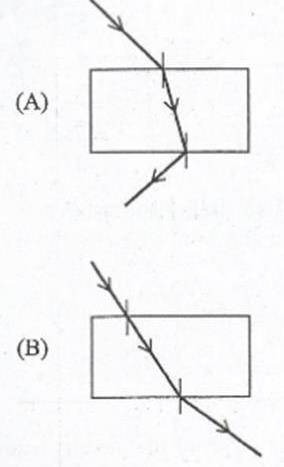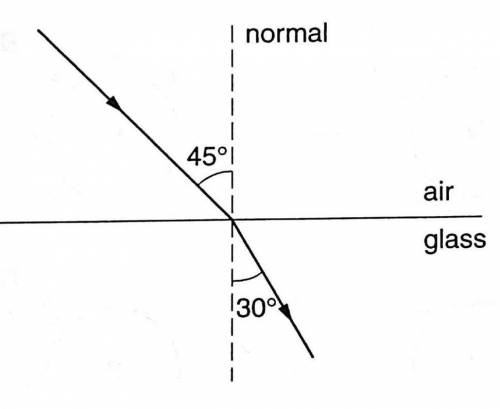
Which of the following diagrams does illustrate what happens when a ray of light meets an air-water boundary?
a
A
b
B
c
C
d
D
Question 11 (1 point)
The diagram shows light travelling from air into glass.
Four angles V , W , X and Y are shown.
Which formula is used to calculate the refractive index , n , of the glass ?
a
n = sin w / sin x
b
n = sin v / sin y
c
n = sin w / sin y
d
n = sin v / sin x
Question 12 (1 point)
Light travels in a vacuum and then enters a glass block. The speed of the light in the glass block is 2.0 × 10 8 m s -1.
Which statement about the speed of light is correct?
a
The speed in the glass is 1.5 times the speed in the vacuum
b
The speed in the vacuum is 1.5 times the speed in the glass
c
The speed in the vacuum is same as the speed in the glass
d
The speed in the glass is 1.0 × 10 8 times the speed in a vacuum.
Question 13 (1 point)
A ray of light in air strikes a glass boundary at an angle of 0° . The light will be:
a
totally reflected
b
undeviated
c
refracted at an unknown angle
d
refracted at 90 degrees to the normal
Question 14 (1 point)
Light travelling in glass is incident on the glass-air boundary as shown. The angle of incident of the light is greater than the critical angle.
Which arrow shows the direction of the light after it is incident on the boundary ?
a
A
b
B
c
C
d
D
Question 15 (1 point)
Which diagram best shows the path taken by the ray of light through the rectangular glass block ?
a
A
b
B
c
C
d
D
Question 16 (1 point)
A ray of light entering the eye changes direction. Thia effect is called:
a
Refraction
b
Interference
c
Reflection
d
Diffraction
Question 17 (1 point)
Total internal reflection in a medium occurs only when the angle of incidence:
a
equals the angle of refraction
b
equals 90
c
is less than the critical angle
d
is greater than the critical angle
Question 18 (1 point)
_ Which of the following statements MUST be true if total internal reflection is to occur?
I. The angle of refraction must be 90º
II. The angle of incidence must be equal to the angle of refraction
III. The angle of incidence must be greater than the critical angle
IV. Light must be travelling from one medium to a less optically dense medium.
a
III and IV only
b
I and II only
c
I and III only
d
II and III only
Question 19 (1 point)
A ray of light travels from air to glass as shown.
The speed of light in air is 3.00 x 10 8 m s-1.
What is the speed of light in the glass ?
a
3.00 x 10 8 m/s
b
2.00 x 10 8 m/s
c
4.24 x 10 8 m/s
d
2.12 x 10 8 m/s






Answers: 2


Another question on Physics

Physics, 21.06.2019 23:20
Imagine you had to physically add electrons, one at a time, to a previously neutral conductor. you add one electron very easily, but the second electron requires more work. in your initial post to the discussion, explain why this is. also, what happens to the work needed to add the third, fourth, fifth, and subsequent electrons
Answers: 1

Physics, 22.06.2019 02:00
What is created when solids,liquids,an gases mix with one another
Answers: 1

Physics, 22.06.2019 06:00
The frequency of vibrations of a vibrating violin string is given by f = 1 2l t ρ where l is the length of the string, t is its tension, and ρ is its linear density.† (a) find the rate of change of the frequency with respect to the following. (i) the length (when t and ρ are constant) (ii) the tension (when l and ρ are constant) (iii) the linear density (when l and t are constant) (b) the pitch of a note (how high or low the note sounds) is determined by the frequency f. (the higher the frequency, the higher the pitch.) use the signs of the derivatives in part (a) to determine what happens to the pitch of a note for the following. (i) when the effective length of a string is decreased by placing a finger on the string so a shorter portion of the string vibrates df dl 0 and l is ⇒ f is ⇒ (ii) when the tension is increased by turning a tuning peg df dt 0 and t is ⇒ f is ⇒ (iii) when the linear density is increased by switching to another string df dρ 0 and ρ is ⇒ f is ⇒
Answers: 3

Physics, 22.06.2019 10:10
Apair of 10μf capacitors in a high-power laser are charged to 1.7 kv.a. what charge is stored in each capacitor? b. how much energy is stored in each capacitor?
Answers: 2
You know the right answer?
Which of the following diagrams does illustrate what happens when a ray of light meets an air-water...
Questions

Mathematics, 04.12.2020 15:50

Mathematics, 04.12.2020 15:50




Computers and Technology, 04.12.2020 15:50

Mathematics, 04.12.2020 15:50


English, 04.12.2020 15:50

English, 04.12.2020 15:50

Mathematics, 04.12.2020 15:50


English, 04.12.2020 15:50



History, 04.12.2020 15:50

Mathematics, 04.12.2020 15:50

Advanced Placement (AP), 04.12.2020 16:00

History, 04.12.2020 16:00

History, 04.12.2020 16:00



